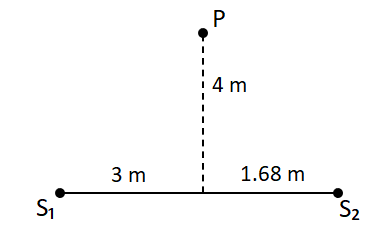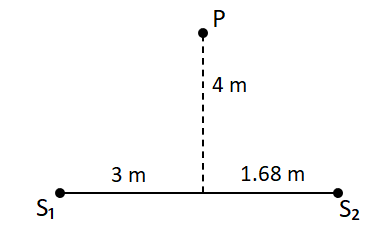
Two sound sources \[{S_1}\] and \[{S_2}\] emit pure sinusoidal waves in phase. If the speed of sound is 330 m/s, then for what frequencies does constructive interference occur at P?

A. 500 Hz
B. 1000 Hz
C. 1200 Hz
D. 1500 Hz
Answer
218.4k+ views
Hint:To solve this question we have to use the relationship between the frequencies for constructive interference and the path difference of two given sound sources. Path difference can be obtained by using Pythagoras theorem.
Formula used:
Path difference for constructive interference is given as,
\[\Delta x = n\lambda = n\left( {\dfrac{v}{f}} \right)\]
Where n is an integer, \[\lambda \] is the wavelength, v is the speed of sound and f is the frequency.
Complete step by step solution:
Given the speed of sound v = 330 m/s
If the line PO is perpendicular to the line joining the two sound sources \[{S_1}\]and\[{S_2}\].
Separation between the two sound sources \[{S_1}\] and \[{S_2}\], \[{S_1}{S_2}\]= 4.68M

Image: Separation between the two sound sources \[{S_1}\] and \[{S_2}\].
From the given data, we have
\[{S_1}P = \sqrt {{3^2} + {4^2}} = 5\]
And,
\[{S_2}P = \sqrt {{4^2} + {{1.68}^2}} = 4.338\]
As we know that Path difference,
\[\Delta x = \left| {{S_1}P - {S_2}P} \right| \\ \]
\[\Rightarrow \Delta x = 5 - 4.338 \approx 0.66 \\ \]
Also, we know that for constructive interference,
\[\Delta x = n\lambda = n\left( {\dfrac{v}{f}} \right)\]
where n = 1,2, 3…...
Now the frequency is given as,
\[f = \dfrac{{nv}}{{\Delta x}} \\ \]
\[\Rightarrow f = \dfrac{{n \times 330}}{{0.66}} \\ \]
\[\Rightarrow f = 500n{\rm{ Hz}}\]
For n = 0, frequency, f = 0
For n = 1, frequency, f = 500 Hz
For n = 2, frequency, f = 1000 Hz
For n = 3, frequency, f = 1500 Hz
and so on.
Therefore, for the frequencies constructive interference occurs at P is 500 Hz, 100 Hz, 1500 Hz and so on.
Hence option A, B and D is the correct answer.
Note: The difference in distance travelled by the two waves is defined as the one full wavelength or the path difference is \[1\lambda \]. When the path difference (\[\Delta x\]) is one full wavelength then a crest meets a crest and constructive interference occurs.
Formula used:
Path difference for constructive interference is given as,
\[\Delta x = n\lambda = n\left( {\dfrac{v}{f}} \right)\]
Where n is an integer, \[\lambda \] is the wavelength, v is the speed of sound and f is the frequency.
Complete step by step solution:
Given the speed of sound v = 330 m/s
If the line PO is perpendicular to the line joining the two sound sources \[{S_1}\]and\[{S_2}\].
Separation between the two sound sources \[{S_1}\] and \[{S_2}\], \[{S_1}{S_2}\]= 4.68M

Image: Separation between the two sound sources \[{S_1}\] and \[{S_2}\].
From the given data, we have
\[{S_1}P = \sqrt {{3^2} + {4^2}} = 5\]
And,
\[{S_2}P = \sqrt {{4^2} + {{1.68}^2}} = 4.338\]
As we know that Path difference,
\[\Delta x = \left| {{S_1}P - {S_2}P} \right| \\ \]
\[\Rightarrow \Delta x = 5 - 4.338 \approx 0.66 \\ \]
Also, we know that for constructive interference,
\[\Delta x = n\lambda = n\left( {\dfrac{v}{f}} \right)\]
where n = 1,2, 3…...
Now the frequency is given as,
\[f = \dfrac{{nv}}{{\Delta x}} \\ \]
\[\Rightarrow f = \dfrac{{n \times 330}}{{0.66}} \\ \]
\[\Rightarrow f = 500n{\rm{ Hz}}\]
For n = 0, frequency, f = 0
For n = 1, frequency, f = 500 Hz
For n = 2, frequency, f = 1000 Hz
For n = 3, frequency, f = 1500 Hz
and so on.
Therefore, for the frequencies constructive interference occurs at P is 500 Hz, 100 Hz, 1500 Hz and so on.
Hence option A, B and D is the correct answer.
Note: The difference in distance travelled by the two waves is defined as the one full wavelength or the path difference is \[1\lambda \]. When the path difference (\[\Delta x\]) is one full wavelength then a crest meets a crest and constructive interference occurs.
Recently Updated Pages
Young’s Double Slit Experiment Derivation Explained

Wheatstone Bridge Explained: Working, Formula & Uses

Chemical Properties of Hydrogen - Important Concepts for JEE Exam Preparation

JEE General Topics in Chemistry Important Concepts and Tips

JEE Atomic Structure and Chemical Bonding important Concepts and Tips

JEE Amino Acids and Peptides Important Concepts and Tips for Exam Preparation

Trending doubts
JEE Main 2026: Application Form Open, Exam Dates, Syllabus, Eligibility & Question Papers

Derivation of Equation of Trajectory Explained for Students

Hybridisation in Chemistry – Concept, Types & Applications

Understanding the Angle of Deviation in a Prism

Understanding Collisions: Types and Examples for Students

Understanding Atomic Structure for Beginners

Other Pages
JEE Advanced Marks vs Ranks 2025: Understanding Category-wise Qualifying Marks and Previous Year Cut-offs

How to Convert a Galvanometer into an Ammeter or Voltmeter

Understanding Centrifugal Force in Physics

Ideal and Non-Ideal Solutions Explained for Class 12 Chemistry

Degree of Dissociation: Meaning, Formula, Calculation & Uses

Understanding Electromagnetic Waves and Their Importance




